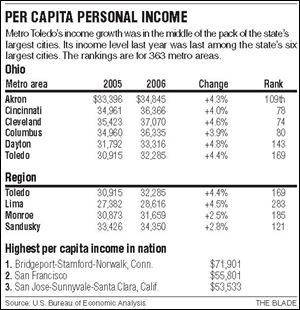
Toledo-area incomes up, but still lag state, nation
8/8/2007
<img src=http://www.toledoblade.com/assets/gif/weblink_icon.gif> <font color=red><b>ALSO ONLINE:</b> <a href=" /apps/pbcs.dll/article?AID=/20070808/NEWS34/70808072" target="_blank "><b>Shuttle blasts off with former teacher aboard</b></a>
Terry Renna / AP
The income gap dividing metro Toledo from the nation overall continued to widen last year even as this area posted the biggest gains in nearly a decade, a new report shows.
The U.S. Commerce Department said that per capita personal income rose 4.4 percent to $32,285. That was $1,370 higher than in 2005.
It was the best performance since 1998, when the region, which includes Lucas, Wood, Fulton, and Ottawa counties, notched an identical increase.
But the metro area continued to lose ground on the rest of the nation, which recorded a 5.3 percent increase in per capita income to $36,307, the preliminary figures show.
Still, among Ohio s six biggest cities, only Dayton and Cleveland recorded bigger percentage gains than Toledo.
Ken Mayland of ClearView Economics in Cleveland attributes the increases to a combination of inflationary pressure and business growth.
Part of it is the ongoing expansion of the economy, he said. The unemployment rate has come down. Labor markets have tightened. With that, there have been faster wage gains.
Wages are one component of personal income, which also includes such things as bank interest, stock dividends, and rent collected by landlords.
Meanwhile, prices of consumer goods rose 3.2 percent last year after climbing 3.4 percent in 2005 and 2.7 percent in 2004, he noted.
On the downside, local gains are also a reflection of the metro area s declining population, which slipped by 1,922 to 653,695 in 2006, according to U.S. Census Bureau estimates.

The Commerce Department s Bureau of Economic Analysis compiled the personal income report by adding total income of all people in the area, and then dividing by the population.
Economists caution, however, that the resulting figure is more a reflection of a region s overall wealth than how much individuals and families make on average.
Combined income of everyone in metro Toledo rose by 4.1 percent to $21 billion in 2006, the report stated.
Among Ohio s six biggest cities, per capita income in metro Toledo continues to rank last, behind Akron, Cincinnati, Cleveland, Columbus, and Dayton.
Toledo ranks 169th among the nation s 363 metropolitan areas. Other regional cities included in the report were Lima, ranked 283rd; Monroe, 185th, and Sandusky, 121st.
The highest per capita income nationally is in Bridgeport-Stamford-Norwalk, Conn., at $71,901. The lowest among the metro areas nationally was McAllen, Texas, at $17,111.
Personal income grew in nearly 70 percent of the nation s metro areas, with some of the biggest gains made by New Orleans and other Gulf Coast cities hit by Hurricane Katrina, federal economists said.
A common denominator among big gainers was oil and gas-drilling and petroleum processing.
Contact Gary Pakulski at: gpakulski@theblade.com or 419-724-6082.